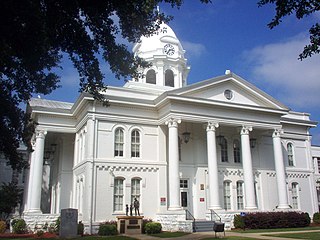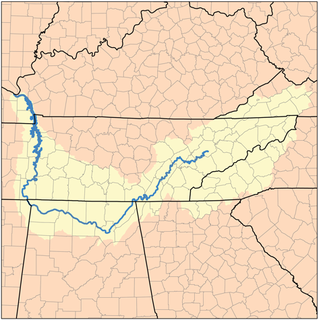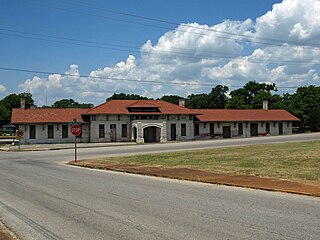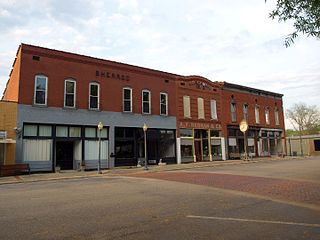 | |
| Locale | North Alabama |
|---|---|
| Dates of operation | 1832–1850 |
| Successor | Memphis and Charleston Railroad |
| Track gauge | 5 ft (1,524 mm) |
Incorporated on January 13, 1832, the Tuscumbia, Courtland and Decatur Railroad was a railroad in Alabama, the United States.
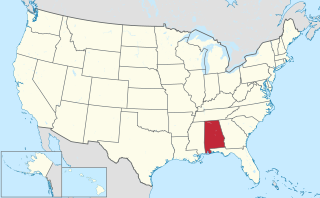
Alabama is a state in the southeastern region of the United States. It is bordered by Tennessee to the north, Georgia to the east, Florida and the Gulf of Mexico to the south, and Mississippi to the west. Alabama is the 30th largest by area and the 24th-most populous of the U.S. states. With a total of 1,500 miles (2,400 km) of inland waterways, Alabama has among the most of any state.

The United States of America (USA), commonly known as the United States or America, is a country comprising 50 states, a federal district, five major self-governing territories, and various possessions. At 3.8 million square miles, the United States is the world's third or fourth largest country by total area and is slightly smaller than the entire continent of Europe. With a population of over 327 million people, the U.S. is the third most populous country. The capital is Washington, D.C., and the most populous city is New York City. Most of the country is located contiguously in North America between Canada and Mexico.
Contents
The Tuscumbia, Courtland and Decatur Railroad ran from Decatur in Morgan County through the northern half of Lawrence County through Courtland, then into Colbert County and ended in Tuscumbia, Alabama where it connected to the Tuscumbia Railway Company. [1]

Decatur is a city in Morgan and Limestone counties in the U.S. state of Alabama. The city, nicknamed "The River City", is located in Northern Alabama on the banks of Wheeler Lake, along the Tennessee River. It is the largest city and county seat of Morgan County. The population in 2010 was 55,683.

Morgan County is a county in the north central part of the U.S. state of Alabama. As of the 2010 census the population was 119,490. The county seat is Decatur. The county was created by the Alabama Territorial legislature on February 6, 1818 from land acquired from the Cherokee Indians in the Treaty of Turkeytown, and was originally called Cotaco County. On June 14, 1821 it was renamed in honor of American Revolutionary War General Daniel Morgan of Virginia. It is a prohibition or dry county, though the cities of Decatur, Hartselle, and Priceville are wet.

Lawrence County is a county in the northern part of the U.S. state of Alabama. As of the 2010 census, the population was 34,339. This county has the highest number of residents who identify as Native American of any county in the state. The county seat is Moulton. The county was named after James Lawrence, a captain in the United States Navy from New Jersey.
Construction began in mid-1832, the first segment between Tuscumbia and Leighton was completed in November of that year. Traffic between those two cities began at the day of completion. The second segment between Leighton and Decatur was completed in June 1834. [2]

Leighton is a town in Colbert County, Alabama, United States. It is part of the Florence - Muscle Shoals Metropolitan Statistical Area known as "The Shoals". At the 2010 census the population was 729. Leighton has been hit by several tornadoes in the 2000s, including a damaging EF2 on May 8, 2008, that was caught on tape flipping over many cars and damaging buildings.
Construction was speedy because of the large cotton industry in North Alabama. Barges could not pass through the rapids caused by the Shoals along the Tennessee River between Florence, and Decatur. The Shoals Canal was congested and the state pursued funding for a railroad between The Shoals and the calmer waters in Decatur. [1]

North Alabama is a region of the U.S. state of Alabama, generally considered to include 16 counties: Blount, Cherokee, Colbert, Cullman, DeKalb, Etowah, Franklin, Jackson, Lauderdale, Lawrence, Limestone, Madison, Marion, Marshall, Morgan, and Winston, with a combined population of 1,000,985, or 20.94% of the state's population as of 2010 Census.
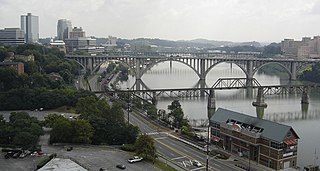
The Tennessee River is the largest tributary of the Ohio River. It is approximately 652 miles (1,049 km) long and is located in the southeastern United States in the Tennessee Valley. The river was once popularly known as the Cherokee River, among other names, as many of the Cherokee had their territory along its banks, especially in eastern Tennessee and northern Alabama. Its current name is derived from the Cherokee village Tanasi.
In 1850 it was incorporated into the Memphis and Charleston Railroad which eventually merged into the Southern Railway, a predecessor of Norfolk Southern. The line is still operated by Norfolk Southern Railway and serves as a vital railroad link between The Shoals, and the city of Decatur.

The Memphis and Charleston Railroad, completed in 1857, was the first railroad in the United States to link the Atlantic Ocean with the Mississippi River. Chartered in 1846, the 311 miles (501 km) 5 ft gauge railroad ran from Memphis, Tennessee to Stevenson, Alabama through the towns of Corinth, Mississippi and Huntsville, Alabama. The portion between Memphis and LaGrange, Tennessee was originally to be part of the LaGrange and Memphis Railroad, chartered in 1838. From Stevenson, the road was connected to Chattanooga, Tennessee via the Nashville and Chattanooga Railroad. In Alabama, the railroad followed the route of the Tuscumbia, Courtland and Decatur Railroad between Tuscumbia and Decatur, the first railroad to be built west of the Appalachian Mountains.

The Norfolk Southern Railway is a Class I freight railroad in the United States. With headquarters in Norfolk, Virginia, the company operates 19,420 miles (31,250 km) route miles in 22 eastern states, the District of Columbia, and has rights in Canada over the Albany to Montréal route of the Canadian Pacific Railway, and previously on CN from Buffalo to St. Thomas. NS is responsible for maintaining 28,400 miles (45,700 km), with the remainder being operated under trackage rights from other parties responsible for maintenance. The most common commodity hauled on the railway is coal from mines in Indiana, Kentucky, Pennsylvania, Tennessee, Virginia, and West Virginia. The railway also offers the largest intermodal network in eastern North America.
